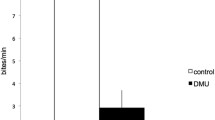Abstract
Many species of freshwater fish with relatively simple mating strategies release hormonally derived sex pheromones in urine. However, it is not known whether species with more complex reproductive strategies use specialized urinary chemical signals. We addressed this by using the Mozambique tilapia (Oreochromis mossambicus Peters 1852), a lek-breeding species in which males establish dominance hierarchies and visiting females mate preferentially with territorial/dominant males. We measured urination frequency of territorial males in social isolation and in the presence of females that were either ready to spawn or had finished spawning. In groups of fish, we monitored the volume of urine stored in subordinate and dominant males to determine if urine volume and olfactory potency (by recording electro-olfactograms, EOG, in females) are related to the male’s social rank. Dominant, territorial males stored more urine than subordinates and released it in short pulses, the frequency of which increased in the presence of females ready to spawn but not in the presence of post-spawn females. Urine from subordinate and dominant males was fractionated by liquid chromatography and fractions tested for olfactory potency by using the EOG, with the most potent fraction analyzed by mass spectrometry (MS). The olfactory system of females was sensitive to a urinary compound that was more abundant in the urine of dominant males than in that of subordinates. MS analysis suggested the compound is a sulfated aminosterol-like compound with a formula of C29H40N2O10S. Therefore, we suggest that dominant/territorial tilapia males dramatically increase urination frequency in the presence of females ready to spawn and that the urinary odorant acts as a pheromonal signal of dominance, thereby influencing female spawning.







Similar content being viewed by others
References
Almeida, O. G., Miranda, A., Hubbard, P. C., Frade, P., Barata, E. N., and Canário, A. V. M. 2005. Urine as a social signal in the Mozambique tilapia (Oreochromis mossambicus). Chem. Senses 30:i309–i310.
Appelt, C. W., and Sorensen, P. W. 1999. Freshwater fish release urinary pheromones in a pulsatile manner, pp. 247–256, in R. E. Johnston, D. Müller-Schwarze, and P. W. Sorensen (eds.). Advances in Chemical Signals in Vertebrates. Kluwer, New York.
Appelt, C. W., and Sorensen, P. W. 2007. Female goldfish signal spawning readiness by altering when and where they release a urinary pheromone. Anim. Behav. 74:1329–1338.
Baerends, G. P., and Baerends van roon, J. M. 1950. An introduction to the study of the ethology of cichlid fishes. Behaviour 1(Suppl.):1–243.
Barata, E. N., Hubbard, P. C., Almeida, O. G., Miranda, A., and Canário, A. V. M. 2007. Male urine signals social rank in the Mozambique tilapia (Oreochromis mossambicus, Peters 1852). BMC Biology 5:54 DOI 10.1186/1741–7007–5–54.
Barlow, G. W. 1991. Mating systems among cichlid fishes, pp. 173–190, in M. H. A. Keenleyside (ed.). Cichlid Fishes: Behaviour, Ecology and EvolutionChapman & Hall, London.
Bruton, M. N., and Boltt, R. E. 1975. Aspects of the biology of Tilapia mossambica Peters (Pisces: Cichlidae) in a natural freshwater lake (Lake Sibaya, South Africa). J. Fish Biol. 7:423–445.
Colombo, L., Marconato, A., Belvedere, P. C., and Frisco, C. 1980. Endocrinology of teleost reproduction. A testicular steroid pheromone in the black goby, Gobius jozo L. Boll. Zool. 47:355–364.
Coward, K., and Bromage, N. R. 2000. Reproductive physiology of female tilapia broodstock. Rev. Fish Biol. Fish. 10:1–25.
Fine, J. M. 2006. Isolation, identification, and biological characterization of the Sea Lamprey (Petromyzon marinus) migratory pheromone. PhD dissertation. University of Minnesota, Twin Cities.
Frade, P., Hubbard, P. C., Barata, E. N., and Canário, A. V. M. 2002. Olfactory sensitivity of the Mozambique tilapia to conspecific odours. J. Fish Biol. 61:1239–1254.
Fryer, G., and Iles, T. D. 1972. The Cichlid Fishes of the Great Lakes of Africa: Their Biology and Evolution. Oliver & Boyd, Edinburgh.
Hoye, T. E., Dvornikovs, V., Fine, J. M., Anderson, K. R., Jeffrey, C. S., Muddiman, D. C., Shao, F., Sorensen, P. W., and Wang, J. 2007. Details of the structure determination of the sulfated steroids PSDS and PADS—new components of the sea lamprey (Petromyzon marinus) migratory pheromone. J. Org. Chem. 72:7544–7550.
Katsel, P. L., Dmitrieva, T. M., Valeyev, R. B., and Kozlov, Y. P. 1992. Sex pheromones of male yellowfin baikal sculpin (Cottocomphorus grewingki): isolation and chemical studies. J. Chem. Ecol. 18:2003–2010.
Liley, N. R. 1982. Chemical communication in fish. Can. J. Fish. Aquat. Sci. 39:22–35.
Miranda, A., Almeida, O. G., Hubbard, P. C., Barata, E. N., and Canário, A. V. M. 2005. Olfactory discrimination of female reproductive status by male tilapia (Oreochromis mossambicus). J. Exp. Biol. 208:2037–2043.
Nelissen, M. H. J. 1991. Communication, pp. 225–240, in M. H. A. Keenleyside (ed.). Cichlid Fishes. Behaviour, Ecology and EvolutionChapman & Hall, London.
Oliveira, R. F. 1995. Etologia social e endocrinologia comportamental da tilápia Oreochromis mossambicus (Teleostei, Cichlidae). PhD dissertation, Universidade de Lisboa.
Oliveira, R. F., and Almada, V. C. 1996. Dominance hierarchies and social structure in captive groups of the Mozambique tilapia Oreochromis mossambicus (Teleostei, Cichlidae). Ethol., Ecol. Evol. 8:39–55.
Oliveira, R. F., and Almada, V. C. 1998a. Mating tactics and male-male courtship in the lek-breeding cichlid Oreochromis mossambicus. J. Fish Biol. 52:1115–1129.
Oliveira, R. F., and Almada, V. C. 1998b. Mating tactics and male-male courtship in the lek-breeding cichlid Oreochromis mossambicus. J. Fish Biol. 52:1115–1129.
Oliveira, R. F., Almada, V. C., and Canario, A. V. M. 1996. Social modulation of sex steroid concentrations in the urine of male cichlid fish Oreochromis mossambicus. Horm. Behav. 30:2–12.
Sorensen, P. W., Fine, J. M., Dvornikovs, V., Jeffrey, C. S., Shao, F., Wang, J., Vrieze, L. A., Anderson, K., and Hoye, T. R. 2005. Mixture of new sulphated steroids functions as a migratory pheromone in the sea lamprey. Nature Chem. Biol. 1:324–328.
Stacey, N., and Sorensen, P. 2006. Reproductive pheromones, pp. 359–412, in K. A. Sloman, R. W. Wilson, and S. Balshine (eds.). Behaviour and Physiology of Fish. Academic, London.
Vermeirssen, E. L. M., and Scott, A. P. 2001. Male priming pheromone is present in bile, as well as in urine, of female rainbow trout. J. Fish Biol. 58:1039–1045.
Wyatt, T. D. 2003. Pheromones and Animal Behaviour. Communication by Smell and Taste. Cambridge University Press, Cambridge.
Acknowledgment
This work was funded by the Ministry of Science and Higher Education and European Social Funds through the Portuguese National Science Foundation (FCT), project POCTI/BSE/38815/2001, and Ph.D. fellowship SFRH/BD/6750/2001 to P. Frade. We thank João Reis (Universidade do Algarve, Faro, Portugal) for technical support and Prof. Luís Dias (Universidade de Évora) for useful discussion on the statistical methods. We also thank the reviewers for their comments.
Author information
Authors and Affiliations
Corresponding author
Rights and permissions
About this article
Cite this article
Barata, E.N., Fine, J.M., Hubbard, P.C. et al. A Sterol-Like Odorant in the Urine of Mozambique Tilapia Males Likely Signals Social Dominance to Females. J Chem Ecol 34, 438–449 (2008). https://doi.org/10.1007/s10886-008-9458-7
Received:
Revised:
Accepted:
Published:
Issue Date:
DOI: https://doi.org/10.1007/s10886-008-9458-7




